
I. INTRODUCTION
In our system, the Smart dustbins are connected to the internet to get the real time information of the smart dustbins. In the recent years, there was a rapid growth in population which leads to more waste disposal. So a proper waste management system is necessary to avoid spreading some deadly diseases. Managing the smart bins by monitoring the status of it and accordingly taking the decision. There are number of dustbins are located throughout the city or the Campus (Educational Institutions, Companies, Hospitals etc.). The aim of the mission is to cover all the rural and urban areas of the country to present this country as an ideal country before the world.With the proliferation of Mobile network devices such as smart phones, sensors, cameras. It is possible to collect massive amount of garbage. In the metropolitan cities it is not possible to check each and every place where the garbage dump yard is full or not. So we have introduced a new concept using ultrasonic sensor. This is a sensor which intimates about the load placed on it. So that the garbage can also be checked in this way. Many times, in our city we see that the garbage bins or dustbins placed at public places are overloaded. It creates unhygienic conditions for people as well as ugliness to that place leaving bad smell. To avoid all such situations we are doing to implement a project called IoT Based Smart Garbage and Waste Collection bins. This system also helps to monitor the fake reports and hence can
reduce the corruption in the overall management system. If the dustbin is not cleaned in specific time, then the record is sent to the higher authority who can take appropriate action against the concerned contractor. This reduces the total number of trips of garbage collection vehicle and hence reduces the overall expenditure associated with the garbage collection. It ultimate helps to keep cleanness in the society. Therefore, the smart garbage management system makes the garbage collection more efficient the use of solar panels in such systems may reduce
the energy consumption. These dust bin model can be applied to any of the smart cities around the world. A waste collecting and monitoring team which is deployed for collection of garbage from the city can be guided in a well manner for collection.
II.SCOPE OF THE PROJECT
Sensor Based Waste Collection Bins is used to identify status of waste bins if it is empty or filled so as to customize the waste collection schedule accordingly and also save the cost. Real time waste management system by using smart dustbins to checkthe fill level of dustbins whether the dustbins are full or not, through this system the information of all smart dustbins can be accessed from anywhere and anytime by the concern person. It will inform the status of each and every dustbin in real time so that concerned authority can send the garbage collection
III.SYSTEM REQUIRMENTS
HARDWARE REQUIREMENTS
• Arduino UNO
• Ethernet Shield
• Gas Sensor
• Ultrasonic Sensor
• UART
• Power supply unit
• Processor :Pentium Dual Core 2.3GHz
• Hard Disk : 250 GB or Higher
• Ram :1 GB (Min)
SOFTWARE REQUIREMENTS
• Arduino IDE
• Embedded C
• Operating System :Windows XP or Higher
• Languages used :Java(JSP, Servlet), HTML
• Tools :JDK 1.7, Net Beans 7.0.1, SQL
IV. SYSTEM DESIGN
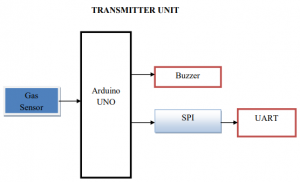

V.EXISTING SYSTEM
Traditionally, wastage bins are emptied at certain intervals by cleaners. This method has some serious health issue for the person who cleaned the dustbin because of the hazardous gases. This leads to overflowing of rubbish bin and poses hygiene risks. It is a challenge to maintain a clean city. It involves several factors such as different stakeholders, financial / economical, collection & transport, etc.
VI.PROPOSED SYSTEM
The ultrasonic sensor used fullness of the smartbin . A Gas sensor node is installed in every Smart bin. The Gas sensor will detect hazardous gases on the dustbin due to some chemical waste and bio-waste. A Gas sensor node is installed in every Smart bin. The Gas sensor will detect hazardous gases on the dustbin due to some chemical waste and bio-waste. The Ethernet shield will be used to update the status of the bin whether it is have hazardous gas or not. The buzzer which gives alert when there is any hazardous gas from the smart bin. Smartbin providers are able to identify and decide whether a particular area needs extra litter bins to be placed nearby or removal and relocate existing litter bins to other places where they are needed.
VII.MODULES
A) HARDWARE SETUP:
Power supply circuits are used to regulate the high voltage ADC from battery power source to low voltage ADC suitable for the microcontroller system. Here power supply of 5v is been given to the controller. It keeps the flow of power in the equal form. Here we are using 7805IC for regulation purpose. Where it converts the 230v supply in to 5v as our system requirement is only 5v.
B) COLLECT DATA:
Gathering data is the common feature of practical work. Sensor technology can enhance this process in many ways. The data gathered is converted to a digital form and is processed at high speed. The data is subsequently retrieved from the objects by using this sensors. Ultrasonic Sensor is a sensor which intimates about the load placed on it. So that the garbage can also be
checked in this way. Gas sensor sense the change in the exhaust smell and smoke and that signal is in analog form. As microcontroller has in build ADC, it will convert that signal in digital form and proceed further. Gas sensor is used to recognize amount of fire emitted smoke.
C) DATA TRANSCEIVING
The Serial Peripheral Interface (SPI) bus is a synchronous serial communication interface specification used for short distance communication, primarily in embedded systems. An Arduino is actually a microcontroller based kit which is basically used in communications and in controlling or operating many devices. The Arduino Ethernet Shield R3 (assembled) allows an Arduino board to connect to the internet. It is based on the Wiz net W5100 Ethernet chip (datasheet).The processed data is sent to SERVER via Ethernet Accordingly, real-time data can be stored and monitored at Cloud servers.
D) DATA PROCESSING
Processing of bio-signals includes pre-processing to eliminate noise from signals and extract useful features for further interpretation. A buzzer is a mechanical, electromechanical, magnetic, electromagnetic, electro-acoustic or piezoelectric audio signalling device.
E) LOCALHOST WITH USER INTERFACE
Concisely, a web server is run at the gateway for hosting a web-page which is user-friendly and able to represent both raw and processed data in text and graphical forms. The web-page provides functions such as a log-in form with a username and a password, or a searching tool.
VII. OUTPUT
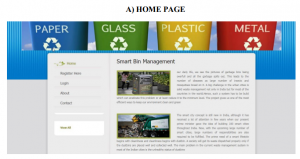
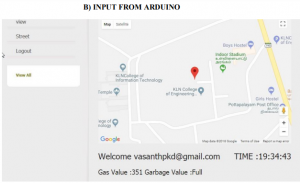
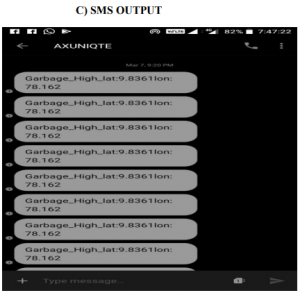
VIII.CONCLUSION
Monitoring the fullness of bins through the use of sensors, it is possible to achieve a more efficient system than the current existing. Our idea of “Smart waste management system”, mainly concentrates on Monitoring the waste management, providing a smart technology for waste system, avoiding human intervention, reducing human time and effort and which results in healthy and waste ridden environment. The system is designed to collect data and to deliver the data through wireless mesh network. The system also employs duty cycle technique to reduce power consumption and to maximize operational time. The Smart bin system was tested in an outdoor environment. In our system, the Smart dustbins are connected to the internet to get the real time information of the smart dustbins.
IX. FUTURE ENHANCEMENT
There are several future works and improvements for the proposed system, 1. Change the system of user’s authentication and atomic lock of bins which would help in securing the bin from any kind of damage or theft. 2. Concept of green-points that would encourage the involvement of the residents or the end users making the idea successful and helping to achieve joined efforts for the waste management and hence fulfilling the idea of Swachch Bharath. 3. Having a case study or data analytics on the type and times the waste is collected on the type of days or season making the bin filling predictable and removing the dependency on electronic components and fixing the coordinates. 4. Improving graphical interfaces for the Server and complete Android applications has possibility of extending the system adding other use cases and applications for smart cities. 5. Moreover, the proposed solution is flexible and decoupled with respect to the determination of optimal number of bins and vehicles or to the algorithm that define the best route for vehicles.

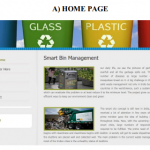
COMMENTS